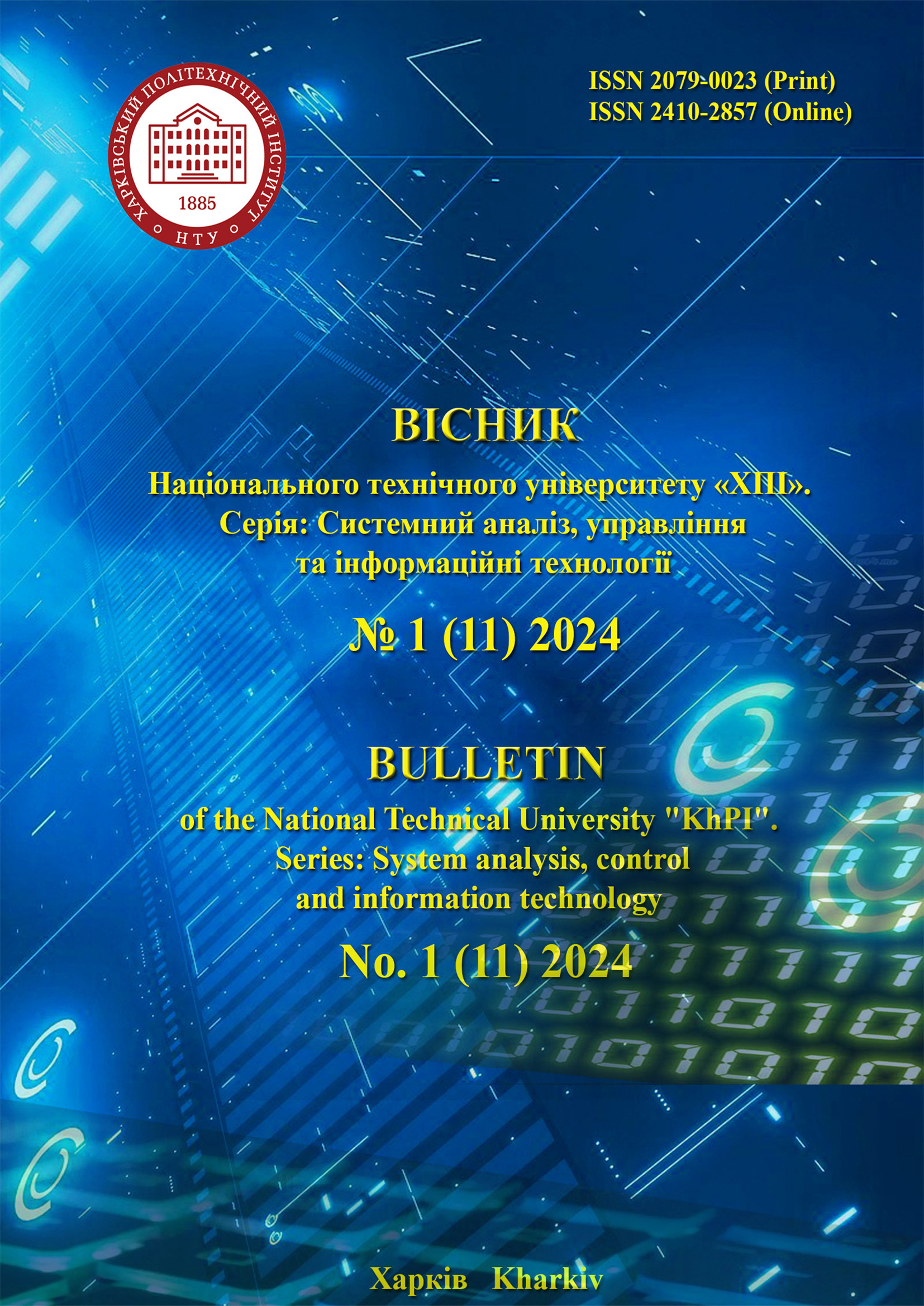MODELS OF REMOTE IDENTIFICATION OF PARAMETERS OF DYNAMIC OBJECTS USING DETECTION TRANSFORMERS AND OPTICAL FLOW
DOI:
https://doi.org/10.20998/2079-0023.2024.01.08Keywords:
remote dynamic object identification, object detection, detection transformer, optical flow, velocity identification, deep learning, convolutional neural networksAbstract
The tasks of remote identification of parameters of dynamic objects are important for various fields, including computer vision, robotics, autonomous vehicles, video surveillance systems, and many others. Traditional methods of solving these problems face the problems of insufficient accuracy and efficiency of determining dynamic parameters in conditions of rapidly changing environments and complex dynamic scenarios. Modern methods of identifying parameters of dynamic objects using technologies of detection transformers and optical flow are considered. Transformer detection is one of the newest approaches in computer vision that uses transformer architecture for object detection tasks. This transformer integrates the object detection and boundary detection processes into a single end-to-end model, which greatly improves the accuracy and speed of processing. The use of transformers allows the model to effectively process information from the entire image at the same time, which contributes to better recognition of objects even in difficult conditions. Optical flow is a motion analysis method that determines the speed and direction of pixel movement between successive video frames. This method allows obtaining detailed information about the dynamics of the scene, which is critical for accurate tracking and identification of parameters of moving objects. The integration of detection transformers and optical flow is proposed to increase the accuracy of identification of parameters of dynamic objects. The combination of these two methods allows you to use the advantages of both approaches: high accuracy of object detection and detailed information about their movement. The conducted experiments show that the proposed model significantly outperforms traditional methods both in the accuracy of determining the parameters of objects and in the speed of data processing. The key results of the study indicate that the integration of detection transformers and optical flow provides reliable and fast determination of parameters of moving objects in real time, which can be applied in various practical scenarios. The conducted research also showed the potential for further improvement of data processing methods and their application in complex dynamic environments. The obtained results open new perspectives for the development of intelligent monitoring and control systems capable of adapting to rapidly changing environmental conditions, increasing the efficiency and safety of their work.
References
Wang Z., Turko R., Shaikh O., Park H., Das N., Hohman F., Kahng M., Chau D. CNN Explainer: Learning Convolutional Neural Networks with Interactive Visualization. URL: https://arxiv.org/abs/2004.15004 (accessed 06.05.2024).
Vaswani A., Shazeer N., Parmar N., Uszkoreit J., Jones L., Gomez A., Kaiser L., Polosukhin I. Attention Is All You Need. URL: https://arxiv.org/abs/1706.03762 (accessed 06.05.2024).
Carion N., Massa F., Synnaeve G., Usunier N., Kirillov A., Zagoruyko S. End-to-End Object Detection with Transformers. URL: https://arxiv.org/abs/2005.12872v3 (accessed 06.05.2024).
Zou Z., Chen K., Shi Z., Shi Z., Guo Y., Ye J. Object
Detection in 20 Years: A Survey. URL: https://arxiv.org/pdf/1905.05055.pdf?fbclid=IwAR0ILGAWTwU-9-iH6lZyPFXYXA5JRWarM_XoSJ78QEhmnn-txvr_iGEzCio (accessed 06.05.2024).
Ammar A., Chebbah A., Fredj H., Souani C. Comparative Study of latest CNN based Optical Flow Estimation. URL: https://ieeexplore.ieee.org/document/9806070/references#references. (accessed 06.05.2024).
Girshick R., Donahue J., Darrell T., Malik J. Rich feature hierarchies for accurate object detection and semantic segmentation. URL: https://arxiv.org/abs/1311.2524 (accessed 06.05.2024).
Girshick R., Donahue J., Darrell T., and Malik J. Region-based convolutional networks for accurate object detection and segmentation. IEEE transactions on pattern analysis and machine intelligence. 2016, vol. 38, no. 1, pp. 142–158.
Nikulina O. M., Severin V. P., Kondratov O. М, Rekova N. Y. Analiz informatsiinykh tekhnolohii dlia dystantsiinoi identyfikatsii dynamichnykh obiektiv [Analysis of information technologies for remote identification of dynamic objects]. Visnyk NTU «KhPI». Seriia: Systemnyi analiz, upravlinnia ta informatsiini tekhnolohii [Bulletin of NTU "KhPI". Series: System analysis, management and information technologies]. Kharkiv, NTU "KhPI" Publ., 2023, no. 1 (9), pp. 110–115.
Nikulina O. M., Kondratov O. М. Model identyfikatsii parametriv dynamichnoho obiektu z vykorystanniam DEtection TRansformer ta Optical Flow [Dynamic object parameter identification model using DEtection TRansformer and Optical Flow]. Informatsiini tekhnolohii: nauka, tekhnika, tekhnolohiia, osvita, zdorovia: Tezy dopovidei XXXII mizhnarodnoi naukovo-praktychnoi konferentsii MicroCAD-2024, 22–24 travnia 2024 r. [Information technologies: science, technology, technology, education, health: Abstracts of reports of XXXII international scientific and practical conference MicroCAD-2024, May 22–24, 2024]. Kharkiv, NTU "KhPI" Publ., 2024, p. 1047.
Nikulina O. M., Kondratov O. М. Metody dystantsiinoi identyfikatsii dynamichnykh parametriv obiekta [Methods of remote identification of dynamic object parameters]. Informatsiini tekhnolohii: nauka, tekhnika, tekhnolohiia, osvita, zdorovia: Tezy dopovidei XXXI mizhnarodnoi naukovo-praktychnoi konferentsii MicroCAD-2023, 17–20 travnia 2023 r. [Information technologies: science, technology, technology, education, health: Abstracts of reports of the XXXI international scientific and practical conference MicroCAD-2023, May 17–20, 2023]. Kharkiv, NTU "KhPI" Publ., 2023, p. 1047.
Zhu X., Hu H., Lin S., Dai J. Deformable ConvNets v2: More Deformable, Better Results. URL: https://arxiv.org/abs/1811.11168 (accessed 06.05.2024).
Inomata T., Kimura K., Hagiwara M. Object Tracking and Classification System Using Agent Search. URL: https://www.jstage.jst.go.jp/article/ieejeiss/129/11/129_11_2065/_pdf/-char/ja (accessed 06.05.2024).
Krizhevsky A., Sutskever I., Hinton G. E. Imagenet classification with deep convolutional neural networks. Advances in neural information processing systems. 2012, pp. 1097–1105.
Downloads
Published
How to Cite
Issue
Section
License

This work is licensed under a Creative Commons Attribution 4.0 International License.
Authors who publish with this journal agree to the following terms:
- Authors retain copyright and grant the journal right of first publication with the work simultaneously licensed under a Creative Commons Attribution License that allows others to share the work with an acknowledgement of the work's authorship and initial publication in this journal.
- Authors are able to enter into separate, additional contractual arrangements for the non-exclusive distribution of the journal's published version of the work (e.g., post it to an institutional repository or publish it in a book), with an acknowledgement of its initial publication in this journal.
- Authors are permitted and encouraged to post their work online (e.g., in institutional repositories or on their website) prior to and during the submission process, as it can lead to productive exchanges, as well as earlier and greater citation of published work (See The Effect of Open Access).


